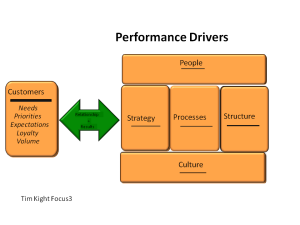Listen to the Radio Show based on this Blog
In this blog I want to focus on Preparing People For Change by over viewing improving people productivity and it’s connection to gaining people’s commitment.
Why is this so important as we climb out of this recession?
It’s a good question…over the last 15 years the odds of making a successful change in North America haven’t changed appreciably. Two thirds of change initiatives fail, including family businesses trying to pass on their company to the next generation. Number 1 reason executives surveyed said “People”
What is your take on the reasons for such a high failure rate?
The performance challenge is greater than ever. How you rebuild and lead an organization to perform near its potential is even more difficult today.
As Tim Kite of Focus3 Consulting says:
It’s challenging because an organization is the sum of its parts piecemeal improvement doesn’t address the organization’s system. To meet this challenge you need to be really clear on the difference between performance drivers vs. performance indicators. Too many people focus on the numbers and too little on Drivers:

20 Communication Channels to Get Aligned
• Key Drivers produce performance
• Key Indicators only measure performance (even well designed ones)
• You can’t manage indicators only drivers can be managed
There are Five Drivers that cover your business system
• People – Selection, Development & Retention
• Culture – Clarity, Consistency & Connection
• Strategy – Value Proposition, Marketing, Sales Customer Care, Financial Goals
• Processes – Work Flow
• Structure – Organizational Design, Role, Relationships
When you align these Five Drivers you need to ensure that:
- Culture aligns and motivates people,
- Strategy delivers in line with Customers needs,
- Systems delivers high quality consistently,
- Structure empowers people and smoothes workflow
- People Driver recruits, develops and retains the right people.
How do you assess if these drivers are broken or needs repair broken?
Let’s take costs. To manage costs effectively across the Five Drivers you need clarity as to what are Core and Non-Core expenses or to put it another way what directly contributes to Top Line revenue vs. the cost of doing business which only indirectly contributes to revenue
Core Expenses are what drives Top Line Sales Revenue
So, Core and Non-Core Expenses first. You are likely to find functions which are internally misaligned present opportunities for improved productivity. Coupled with this is looking at inefficiencies when functions work collaborate with each other
Consider a company with nine functions, such as Production, Marketing, Finance. How many communications channels? You have 9 functions with 9 communication channels less 9 channels within each Function = 72 Communication Channels
Additionally, within one function say you had 50 people 2450 channels potentially.
As you look at these channels you find inefficiencies. Friction between Finance and Marketing is not unusual. So, what happens to communication flows? Communication reduces and fall back on being formal and response times get slower. We call these Expectation Gaps
Expectations Gaps Are like Pot Holes. Fill them quickly before damage occurs
It sounds like they don’t know “who’s on first” and even if they did no one is holding people accountable good starting point?
Exactly. It’s like many poor performing teams at least one of the following will apply:
• Four Team members called Everybody, Somebody, Anybody, and Nobody.
• There was an important job to be done.
• Everybody was sure that Somebody would do it.
• Anybody could have done it, but Nobody did it.
• Somebody got angry about that because it was Everybody’s job.
• Everybody thought Anybody could do it, but Nobody realized that Everybody wouldn’t do it.
• It ended up that Everybody blamed Somebody when Nobody did what Anybody could have done.
How expensive is that?
What signs should look for to see if think is going on?
“That’s not what I meant…”
“This is not what I asked for!”
“My colleagues don’t seem to do what I expect…”
“They never tell us the whole story!”
“I can never do anything right!”
“They never send us information; we’re always sending information to them!”
Sound Familiar?
Yes, I know several organizations where those examples would get a lot of nodding. Do you have any idea what misalignment costs?
60%+ of change initiatives fail in North America
70%+ of leaders expectations are
not understood by their people about a major change
In the last 12 years, 2 in 3 failure rate has not changed Harvard (1996) to McKinsey (2009)
Executives surveyed continue to say the number one reason for such failures is PEOPLE. It really goes into the millions and can close businesses. In one survey 134 public companies average cost of failed IT projects was $12.5m. This does not account for the cost to their cultures and people.
What are the human costs of misalignment?
With misalignment the first to go is Trust coupled to a Fear Of Conflict. When these two exist, a Lack of Commitment grows and its partner Avoiding Accountability rears its ugly head. Finally, silos are reinforced, people do what they have always what they have always done and improved performance doesn’t happen. As these dysfunctions grow over time you will find that the 8OOlb Gorilla feeding on what’s left of your enabling culture.

800lb Gorilla of Mislignmenton a rich culture of unstated expectations and assumptions.
How many of these are due to people not being on the same page?
In our projects 70%+ of leaders’ expectations of each other and those implementing a change have not expressed. Apart from unstated expectations, how do you identify poor expectations
The biggest culprits are the expectations are ambiguous, lack specificity which leads to disappointment, failure and bad feelings etc. here’s some typical language that predicts performance improvement failure:
• “Soon…….”
• ASAP
• “Right Away….”
• “I’ll Try To Get To It………”
• “Later….”
• “By The End Of Next Week
So, Practically what can people do about this when they hear language like this?
First get key players get them to articulates and record expectations then apply:
“The three most important rules in creating accountability cultures are:
Specificity, Specificity, Specificity
Dealing with Expectations Gaps
1. Which expectations gaps are barriers to improving performance and reducing expenses?
2. Who do you need to gain agreement from?
3. Once agreed, ask them to tell you what evidence you will see that your expectation has been met?
4. Then, hold them accountable – “Inspect what you expect”
5. Then, what do you think others expect of you that is connected to these gaps?
6. Now, repeat steps 2,3 & 4
Have you done any projects locally where you have helped fill such expectation gaps?
Ken Genzink, Genzink Steel tried twice over the last five years to reduce his operational management of the Family Steel Fabrication business. On both occasions he had to reengage to save the business.
As says in his testimonial, “I realize now more than ever that many decisions and observations were assumptions”
This resulted in problems like:
• Job Shop Scheduling software didn’t work
• People were cynical about it ever being useful.
• Structural Steel side of the business was losing money due to poor estimating
• Difficulty in retaining skilled people
The Implementation consisted of the following activities:
• Developing a vision for change to reduce dependency on the
• Owner’s day-to-day management.
• Isolate key Alignment Components and their definitions which Ken Genzink saw as crucial to achieving greater market responsiveness and help him devote time to his other businesses
• AlEx™ was then configured specifically for Genzink Steel. AlEx™ is an Automated Accountability Tracking tool that identifies expectations gaps and monitors people’s progress in filling them.
Ken now works at another location devoting the time he needs to the other Family businesses. Gross Revenues have steadily increased from $20 to $30m, and
Genzink is now on the acquisition trail.
Tip of the Month
If you are getting people ready for change
My Expectations of Others
• What I expect you to keep doing
• What I want you to start doing
• What I want you to stop doing
Others’ Expectations of Me
• What things I think others want me to keep to keep doing . . . .
• What new things I think others want me to start doing . . . .
• What things I think others want me to stop doing . . . .
Then meet with those who you need to implement your change and compare your answers – be prepared for surprises.
Listen to the Radio Show
[polldaddy poll=4604847]
Great, but how can this help me?
This is probably the first thing on your mind after reading this Blog. How about asking us? The first call is free! Just email me to set it up. Don’t wait, get TCA working for you!. If our conversation leaves you needing more, we offer at a reasonable fee telephone and video coaching improve bottom line results.
If that still doesn’t do it, we’ll work with you on a solution.
_________________________________________________
[contact-form] [contact-field label=”Name” type=”name” required=”true” /] [contact-field label=”Email” type=”email” required=”true” /] [contact-field label=”Website” type=”url” /] [contact-field label=”Comment” type=”textarea” required=”true” /] [/contact-form] ____________________________________________________________________________
For Help in Getting Your People on the Same Page
Nick Anderson, Senior Partner, PDS Group LTD
E-mail I Web I Linkedin
© Copyright All Rights Reserved, TCA and Walk the Talk – A Blog for Agile Minds, [2010-2011]. Unauthorized use and/or duplication of this material without express and written permission from this blog’s author and/or owner is strictly prohibited. Excerpts and links may be used, provided that full and clear credit is given to Nick Anderson, PDS Group LTD and Walk the Talk – A Blog for Agile Minds with appropriate and specific direction to the original content.


